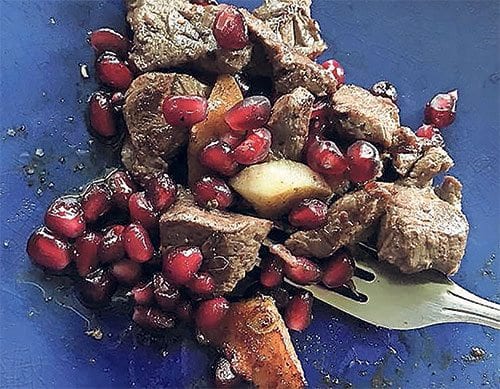
We are lucky to live in an age of pomegranates. With more pomegranates being grown and consumed than ever before in the history of the world, the renaissance is upon us.

Author: Ari LevauxNarnumru is a fried egg atop fried pomegranate arils.
Worldwide, pomegranate consumption is on the rise for culinary and health reasons, and there is demand from cosmetic and pharmaceutical industries, all of which makes for attractive pricing on a fruit that grows by the hundreds on a healthy tree. The trees are low-maintenance and can adapt to many conditions, including heat and drought.
Such conditions are becoming more common in many parts of the world, like in India, the No. 1 producer of pomegranates that continues to expand its acreage by replacing dried-up apple orchards with pomegranates. Spain and Italy have invested big in recent years as well, aiming to feed a growing European demand, while China has invested the most, including large plantations of soft-seeded Tunisian pomegranates, destined mostly for Asia.
Extracting the jewels
Pomegranates are an ancient fruit with a deep history in Central Asia, Persia, the Middle East and the Caucuses. Cookbook author Feride Buyuran is from Azerbaijan, which is like being from all of those places at once. From an early age, she told me by email, she saw pomegranates everywhere.
“In front yards, in backyards, and randomly even in parks. They’re cheaper than apples,” she says.
The arils, of course, are the fleshy seeds inside that tough-skinned, angular sphere. And there are many ways to get them out. A peeled pomegranate looks like the world’s biggest and most delicious freshly cut jewel, but takes a little work.
Buyuran’s website, azcookbook.com, has a video in which she demonstrates how to quickly remove the arils by cutting along the membranes that run between the arils, rather than through them. She then swats the arils from their clingy membranes with a wooden spoon, making it look so easy. Alas, I usually end up clawing it apart with my fingers and dumping the arils in a bowl of water so the membranes float out. But I don’t try to remove every last shred, as the membranes are where many of the fruit’s potentially medicinal compounds reside.
Buyuran has also posted a recipe for a dish called narnumru, from her new book “Pomegranates & Saffron: A Culinary Journey to Azerbaijan.” It’s basically fried eggs atop fried pomegranate arils, which burst open in the pan’s heat and steam the egg sunny side up in the covered pan. It’s a shocking dish, both visually and intellectually. But in your mouth, it all makes perfect sense.
She starts with a half-cup chopped onion in a pan with butter and a little olive oil. When the onions are translucent, she adds two cups of arils (for two eggs), and fries them for a few minutes, before cracking the eggs on top and covering briefly. If you have a glass lid you can watch the eggs turn white before your eyes in the pomegranate steam.
Ari LeVaux writes a syndicated weekly food column that’s appeared in more than 50 newspapers in 25 states. Ari can be reached at flash@flashinthepan.net.






